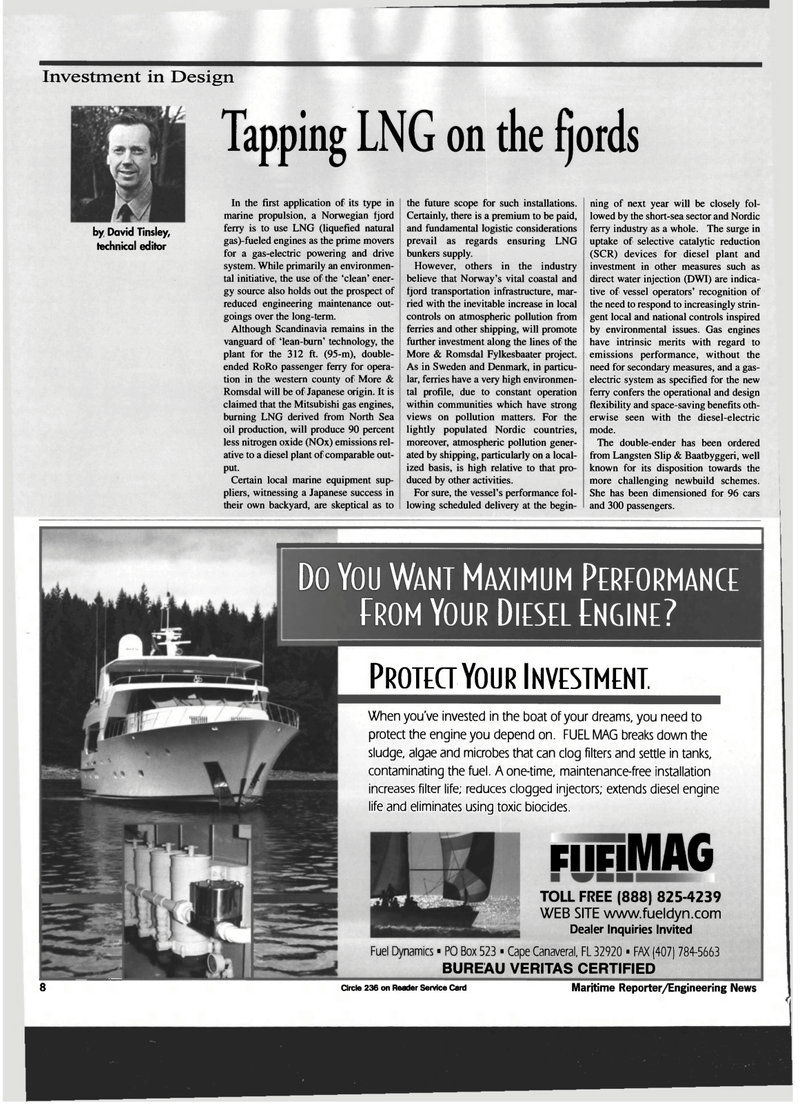
Page 8: of Maritime Reporter Magazine (July 1999)
Read this page in Pdf, Flash or Html5 edition of July 1999 Maritime Reporter Magazine
Investment in Design by David Tinsley, technical editor
Tapping LNG on the fjords
In the first application of its type in marine propulsion, a Norwegian fjord ferry is to use LNG (liquefied natural gas)-fueled engines as the prime movers for a gas-electric powering and drive system. While primarily an environmen- tal initiative, the use of the 'clean' ener- gy source also holds out the prospect of reduced engineering maintenance out- goings over the long-term.
Although Scandinavia remains in the vanguard of 'lean-burn' technology, the plant for the 312 ft. (95-m), double- ended RoRo passenger ferry for opera- tion in the western county of More &
Romsdal will be of Japanese origin. It is claimed that the Mitsubishi gas engines, burning LNG derived from North Sea oil production, will produce 90 percent less nitrogen oxide (NOx) emissions rel- ative to a diesel plant of comparable out- put.
Certain local marine equipment sup- pliers, witnessing a Japanese success in their own backyard, are skeptical as to the future scope for such installations.
Certainly, there is a premium to be paid, and fundamental logistic considerations prevail as regards ensuring LNG bunkers supply.
However, others in the industry believe that Norway's vital coastal and ijord transportation infrastructure, mar- ried with the inevitable increase in local controls on atmospheric pollution from ferries and other shipping, will promote further investment along the lines of the
More & Romsdal Fylkesbaater project.
As in Sweden and Denmark, in particu- lar, ferries have a very high environmen- tal profile, due to constant operation within communities which have strong views on pollution matters. For the lightly populated Nordic countries, moreover, atmospheric pollution gener- ated by shipping, particularly on a local- ized basis, is high relative to that pro- duced by other activities.
For sure, the vessel's performance fol- lowing scheduled delivery at the begin- ning of next year will be closely fol- lowed by the short-sea sector and Nordic ferry industry as a whole. The surge in uptake of selective catalytic reduction (SCR) devices for diesel plant and investment in other measures such as direct water injection (DWI) are indica- tive of vessel operators' recognition of the need to respond to increasingly strin- gent local and national controls inspired by environmental issues. Gas engines have intrinsic merits with regard to emissions performance, without the need for secondary measures, and a gas- electric system as specified for the new ferry confers the operational and design flexibility and space-saving benefits oth- erwise seen with the diesel-electric mode.
The double-ender has been ordered from Langsten Slip & Baatbyggeri, well known for its disposition towards the more challenging newbuild schemes.
She has been dimensioned for 96 cars and 300 passengers.
Do You WANT MAXIMUM PERFORMANCE
FROM YOUR DIESEL ENGINE?
PROTECT YOUR INVESTMENT.
When you've invested in the boat of your dreams, you need to protect the engine you depend on. FUEL MAG breaks down the sludge, algae and microbes that can clog filters and settle in tanks, contaminating the fuel. A one-time, maintenance-free installation increases filter life; reduces clogged injectors; extends diesel engine life and eliminates using toxic biocides. ninMflO
TOLL FREE (888) 825-4239
WEB SITE www.fueldyn.com
Dealer Inquiries Invited
Fuel Dynamics • PO Box 523 • Cape Canaveral, FL 32920 - FAX (407] 784-5663
BUREAU VERITAS CERTIFIED 8 Circle 236 on Reader service Card Maritime Reporter/Engineering News

 7
7

 9
9
